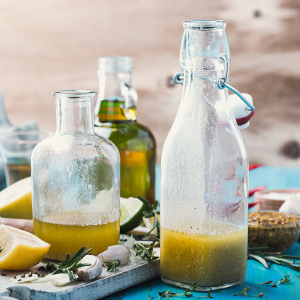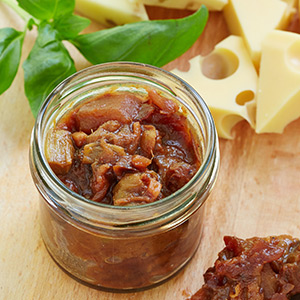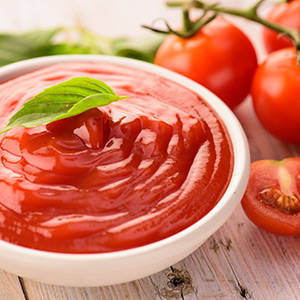- 4 Québec products to add to your recipes
- 10 Ways to Eat More Fruit Every Day
- Brighten up Your Plate with Citrus Fruit
- 12 Fresh Five-Star Salads
- Discover Hot and Sweet Peppers
- Eat More Nuts
- Enjoy Locally Grown Vegetables Year-Round
- Ways to Use Garden Vegetables
- Ketchups, Relishes, Chutneys, Marinades and Aromatic Vinegars
- Cranberries
- Cook with potatoes
- 8 Easy Recipes to Prepare Pumpkin—Differently
- Eat your veggies from the leaves to the roots
- Rediscover Fries!
- Super Salads!
- Eat more chickpeas
- Fruits and vegetables on the barbecue
- Apples on the menu
Ketchups, Relishes, Chutneys, Marinades and Aromatic Vinegars

From sweet preserves, let's move on to the sweet and sour world of ketchups, relishes, chutneys, marinades and flavoured vinegar.
Marinated vegetables
A marinated vegetable is a vegetable that is macerated in a seasoned liquid to impart flavour. It can be a mixture of wine, salty, spicy or flavoured vinegar, and fresh herbs, garlic or onion.
Most vegetables need to be salted to rid them of excess water
This prevents dilution of the acid needed to preserve the vegetables for any length of time. This is normally done using coarse salt and the quantity of salt depends on the water content of the vegetables used. The more water content in a vegetable, the more salt is needed and the longer it should be left to macerate. Once macerated, the vegetables should be rinsed thoroughly to remove the salt and then drained.
The choice of vinegar is also important
White vinegar will render clear marinades while malt vinegar, cider vinegar and herb or spiced vinegars will render darker marinades. It is best to wait six to eight weeks before using the marinades to give the vegetables enough time to absorb all of the aromas. Almost all vegetables can be marinated. Gherkins and miniature cucumbers are used to make marinated pickles. They are first cleaned thoroughly under cold water, then dried and placed in a container of coarse salt for 24 hours. They are then drained and rinsed under cold water and then put in the vinegar solution of your choice.
Marinated mushrooms are also excellent
The best varieties to marinate are oyster, shiitake and coffee mushrooms. Onions, string beans, peppers, artichoke, carrots, cauliflower and beets are also classics. Vegetables are first cleaned and cut into uniform pieces then sprinkled with coarse salt and left to rest for a few hours. They are then rinsed thoroughly under cold water and put in a mixture of salt, sugar, vinegar and spices.


Relishes
Relishes are sweet and sour sauces made with acidic fruits combined with vegetables like cucumbers, onions, and cauliflower, then simmered in vinegar and very fragrant spices like ginger, cinnamon and pepper.
Chutneys
Chutneys are a sweet and spicy vegetable mixture made of onions, raisins and vinegar-macerated fruit and vegetable pulp. They can be flavoured with a variety of ingredients including mango, tamarind, coconut, mint and lemon. Chutneys offer a wide array of aromas and tastes. Like ketchups and relishes, chutneys are served as condiments to enhance a variety of meat and fish dishes.
Ketchups
The most famous tomato ketchup was first put on the market in 1869 by H.J. Heinz and soon became America's favourite ketchup. The sauce was inspired by chutneys and Oriental soy-based sauces but contained more tomatoes and was puréed to a uniform consistency.
Origins of Ketchup
Ketchup is actually a mixture of tomato sauce, onions, vinegar, brown sugar and spices. First called catsup, the word comes from ketjap, a variety of Hindu or Indonesian chutney. All ketchups start with tomatoes to which fruits such as apples, peaches or pears are added. For best results when making ketchups, we recommend using tomatoes that have high water content.

Tips on canning and preserving
- Jars must first be sterilized; ideally, transparent glass jars should be used so that the colour of the vinegar, herbs and spices is readily visible.
- Rice, balsamic, wine and malt vinegars can be enhanced by the addition of fresh herbs, fruit or spices. These vinegars can then be used to flavour stews, casseroles, soups and, of course, salads.
- Herbs must be fresh and clean. The best fruits to use are raspberries, blueberries, strawberries and citrus. Lightly crush the herbs, spices or fruit to release their full aroma then insert into sterilized jars or bottles and pour the vinegar right to the top. Cap the bottles well and let macerate for a few weeks.
- The vinegar will be clearer and will keep longer if it is filtered following maceration. Several filterings are sometimes necessary to obtain perfect results. Properly filtered, these flavoured vinegars will keep for one year. Storage life at room temperature is shorter when large amounts of garlic and fresh herbs are used and the vinegar is not filtered after maceration. Vinegars should not be stored in warm environments because they will ferment and lose their flavour.
Expert tip
Always select quality vinegar with at least 5 degree acetic acid content such as wine vinegar, cider vinegar or xérès.
















